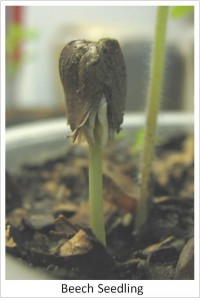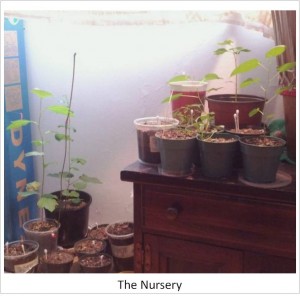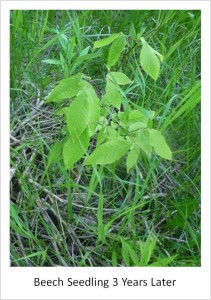March 2, 2013
One Seed at a Time: Restoring the Diversity of Southern Ontario’s Carolinian Forests
“Society grows great when people plant trees whose shade they will never sit in.” – Greek Proverb
A few years ago, after having taken many courses at the University of Toronto on forestry, plant biology, soil science, and physical geography, I realized that I had never so much as gotten my hands dirty, and certainly hadn’t applied the wealth of botanical knowledge I had been so busy accumulating. So one day, inspired by a white elm seed that somehow drifted into my 12thstorey apartment window, I decided to grow some trees. My initial focus was on native tree species that were now somewhat rare in Southern Ontario—pawpaw (Asimina triloba), white pine (Pinus strobus), white and red elm (Ulmus americana and U. rubra), sycamore (Platanus occidentalis), American chestnut (Castanea dentata), butternut (Juglans cinerea), Kentucky coffee tree (Gymnocladus dioicus), red mulberry (Morus rubra), shagbark hickory (Carya ovata), and American beech (Fagus grandifolia), to name but a few. I quickly became an avid collector of tree seeds and would often return home with my pockets bursting at the seams with the embryonic constituents of our native forests.
My tiny, balcony-less bachelor apartment in the dense concrete jungle of St. James Town in downtown Toronto only receives about three or four hours of direct sunlight each day—not an ideal nursery for our native trees, but I figured it was better than nothing. My small window sill quickly proved to be inadequate for my assemblage of makeshift pots, so I fashioned an addition to it to make more room to grow. When this added space proved inadequate for my burgeoning urban forest, I began to germinate seeds under a humble 100 watt halogen lamp.
When I began I had no clear plans for my little trees, I was simply curious to grow them and was fascinated by their development. I found the experience very humbling, and realized that despite the “book” knowledge one might have, there is no substitute for simple trial and error.
The first enemies to plague my woody brood were fungus gnats, who infiltrated my apartment via transplanted soil or through an open window. Fungus gnats superficially resemble fruit flies, and have similar life cycles. They have the nasty habit of burrowing into the soil of house plants and laying an abundance of eggs. Their larvae seem to have voracious appetites and feed on the roots of potted plants, at best stunting plant growth, but at worst killing young seedlings en masse. I was unable to find any suitable information on how to repress fungus gnats on the internet, and hundreds of my seedlings fell prey to their appetites over many frustrating months. One day, however, I discovered a means to eradicate them using the same mechanism that yields so many profound scientific discoveries—chance! I had hoped that a certain species of spider that frequented my apartment would be a natural predator of fungus gnats, so I moved several individuals to the area where I was growing my trees. In order to get the spiders to stay in that area, I quickly learned that I needed to provide them with a source of water, so I would regularly fill bottle caps and lids with water and leave them near the little predators. After moving a new spider to the vicinity of my seedlings, I realized I was out of appropriate spider drinking vessels, and used the lid from a jar of recently finished sunflower seed oil. The lid, as it turns out, was not entirely clean, and still contained traces of the oil. I had previously noticed that fungus gnats took advantage of the water I left out for the spiders, perhaps because it was more easily accessible than the water in the soil of my potted seedlings.
 When I returned home that night I was surprised to find a dozen or so fungus gnats floating dead in the lid of the sunflower seed oil, and several others crawling with difficulty around it, unable to fly, like sea birds in an oil slick. I seized upon this chance discovery, and applied a coat of sunflower seed oil to the rims of all my pots (which were the perches of choice of the gnats). To expedite the eradication of the gnats I went a step further and dipped the ends of Q-Tips in oil and stuck them directly into the soil in my pots. These convenient perches proved irresistible—and deadly—to the gnats. Within a couple of weeks the legion of gnats was all but gone, and I have not seen a single one in the last couple of years. But the gnats weren’t the only herbivores to plague my little trees.
When I returned home that night I was surprised to find a dozen or so fungus gnats floating dead in the lid of the sunflower seed oil, and several others crawling with difficulty around it, unable to fly, like sea birds in an oil slick. I seized upon this chance discovery, and applied a coat of sunflower seed oil to the rims of all my pots (which were the perches of choice of the gnats). To expedite the eradication of the gnats I went a step further and dipped the ends of Q-Tips in oil and stuck them directly into the soil in my pots. These convenient perches proved irresistible—and deadly—to the gnats. Within a couple of weeks the legion of gnats was all but gone, and I have not seen a single one in the last couple of years. But the gnats weren’t the only herbivores to plague my little trees.
 After ridding my apartment of the fungus gnats my seedlings rapidly began to thrive and out-grow their pots. I was ready for the next step—putting the seedlings in the ground in a place where they could grow undisturded by humans or other pests. Conveniently, my parents live on a ten acre plot of former agricultural land on the Oak Ridges Moraine near Caledon. Since purchasing this property in 2002 and deciding not to continue cutting the grass of their rolling meadows, native trees like cedars (Thuja occidentalis), balsam poplar (Populus balsamifera), and red pine (Pinus resinosa) had slowly but surely begun to recolonize the site. But tree diversity was low and reforestation rates were slow. Given my knowledge and nascent expertise in forestry, I felt obliged to change this. So one spring day I went up to my parents with a couple dozen healthy seedlings and began to plant. I was quite familiar with the soil profiles of their land and was well aware of the preferred habitat of each species of my seedlings. I remember taking great care in selecting a spot for each seedling and ensuring that each was transplanted without doing it harm.
After ridding my apartment of the fungus gnats my seedlings rapidly began to thrive and out-grow their pots. I was ready for the next step—putting the seedlings in the ground in a place where they could grow undisturded by humans or other pests. Conveniently, my parents live on a ten acre plot of former agricultural land on the Oak Ridges Moraine near Caledon. Since purchasing this property in 2002 and deciding not to continue cutting the grass of their rolling meadows, native trees like cedars (Thuja occidentalis), balsam poplar (Populus balsamifera), and red pine (Pinus resinosa) had slowly but surely begun to recolonize the site. But tree diversity was low and reforestation rates were slow. Given my knowledge and nascent expertise in forestry, I felt obliged to change this. So one spring day I went up to my parents with a couple dozen healthy seedlings and began to plant. I was quite familiar with the soil profiles of their land and was well aware of the preferred habitat of each species of my seedlings. I remember taking great care in selecting a spot for each seedling and ensuring that each was transplanted without doing it harm.
 A couple of weeks after that initial planting I couldn’t wait to get back up there to check up on my little trees. When I returned, however, I found that almost nothing remained! Over a year of work had been wiped out seemingly overnight. A few dry stems remained here and there, but without a single leaf or bud on them. I examined the planting sites like a forensic scientist, and quickly concluded who was at fault: deer. I had regularly seen deer browsing in my parents’ fields and was always grateful to behold them. But now their Bambi-esque benignity began to take on a sinister spectre. The only survivors from that initial round of transplants were two beech seedlings (who are still doing well today), which are known not to be favoured by deer.
A couple of weeks after that initial planting I couldn’t wait to get back up there to check up on my little trees. When I returned, however, I found that almost nothing remained! Over a year of work had been wiped out seemingly overnight. A few dry stems remained here and there, but without a single leaf or bud on them. I examined the planting sites like a forensic scientist, and quickly concluded who was at fault: deer. I had regularly seen deer browsing in my parents’ fields and was always grateful to behold them. But now their Bambi-esque benignity began to take on a sinister spectre. The only survivors from that initial round of transplants were two beech seedlings (who are still doing well today), which are known not to be favoured by deer.
Unlike the fungus gnats, the deer problem was easy to neutralize. From that point on whenever I planted a seedling I would surround it with home-made bark mulch about a metre in diameter (to prohibit the growth of competing herbaceous plants and help retain soil moisture) and enshroud the planting with a protective dome of chicken wire. This method has proven successful, and my parents land is now peppered with rare native tree seedlings, the oldest of which are about three years in age
I now love the idea of collecting seeds from trees that are surrounded by a sea of concrete on bustling urban streets, or from trees in highly manicured city parks—seeds that have little to no chance of germinating, never mind reaching maturity. Collecting such seeds, germinating them, then transplanting the seedlings to a relatively natural rural setting where they can thrive gives me a feeling of satisfaction that is hard to articulate. I feel as if I am fulfilling a crucial ecological role as a disperser of seeds—a role usually reserved for the likes of squirrels, birds, water, or the wind. I even feel that if the parent trees could feel anything, they would be proud and grateful that a few of their urban offspring found a good home and a good life in the country, where they are free to live out their centuries-long lives in peace, and themselves produce a wealth of viable offspring.
To think (or at least hope) that many of the trees that I continue to grow and transplant will remain and contribute to the biodiversity of the Oak Ridges Moraine long after I am dead and gone is greatly comforting. And biodiversity enhancement is but one of the many ecological and social benefits these trees will provide. They will also serve to sequester atmospheric carbon, improve air and soil quality, purify and enhance the retention of groundwater, mitigate erosion and flooding, moderate microclimate temperatures, and provide food and habitat for wildlife. In a small yet appreciable way, these trees, merely by being given the right to exist, will help to counter the effects of climate change and ecological degradation.
I dream that in a hundred years or more someone with an affinity for our woody cousins might stumble upon a patch of mature mulberry or pawpaw trees on the land my parents currently own and realize that someone, at some point in the past, must have planted those trees as a small recompense for the carnage humans have wrought on Southern Ontario’s Carolinian forests—the most biologically diverse and most threatened forests in all of Canada. Perhaps I am just taking this ancient Greek proverb literally: “Society grows great when people plant trees whose shade they will never sit in.” Perhaps it was meant to be taken literally.
Blog written by Derek May, CC-RAI/ORCCC Graduate Assistant





Comments are closed here.